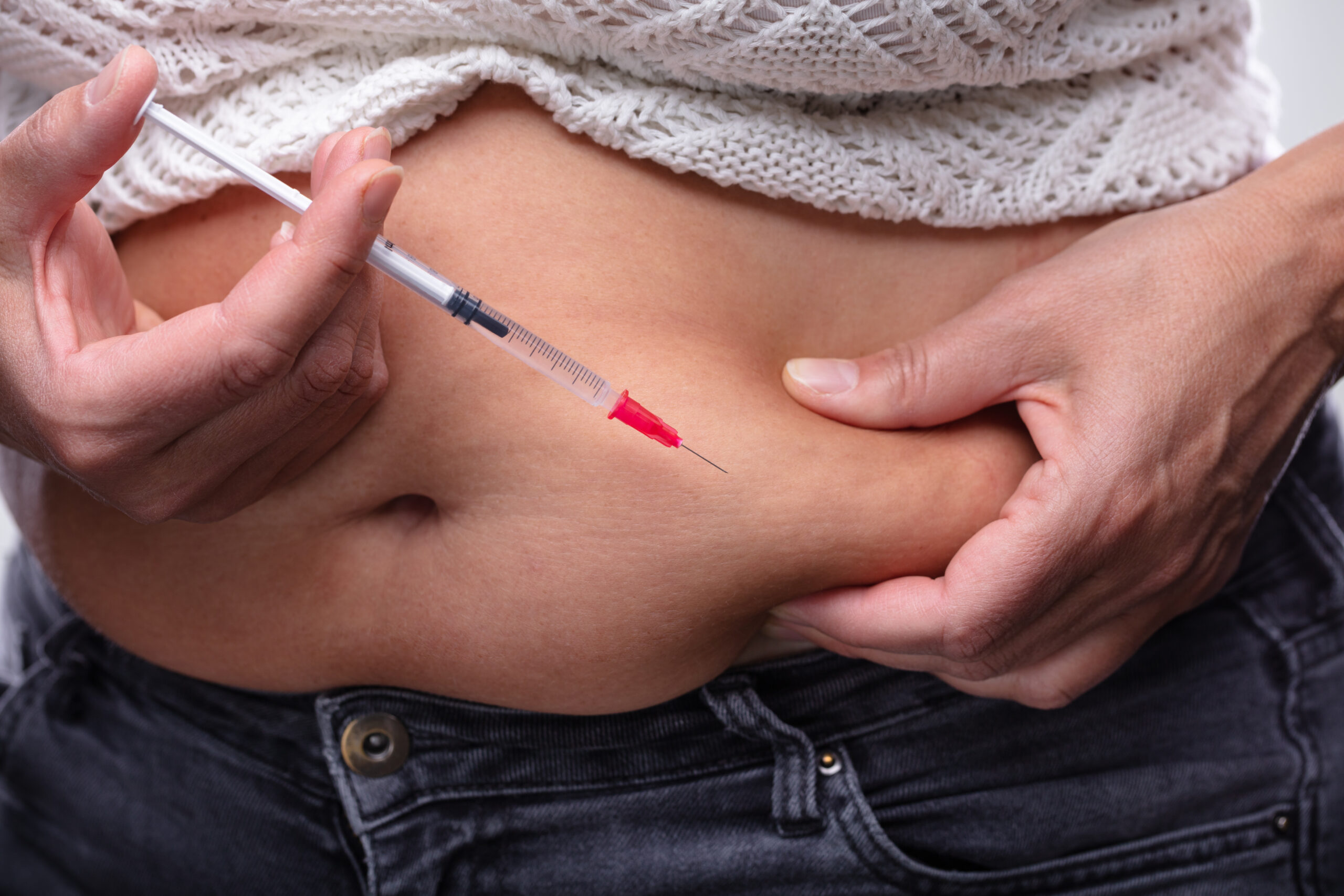“This article originally appeared on InBody USA and is reposted here with permission.”
When you think about diabetes, what is the first thing that pops into your head? Is it caused by having too much fat? Or how a person living with diabetes can’t eat bread, sugar, or carbohydrates? Or that they should stick to a high-fat diet to lose weight and control blood glucose? Do you ever think about how body fat affects insulin resistance? Let’s get into that.
Diabetes is a leading public health crisis affecting more than 30 million people in the U.S. People with diabetes have a chronic illness that requires them to control their elevated blood glucose levels, a result of a phenomenon known as insulin resistance. But what causes this condition to occur?
First, let’s talk about glucose. The sugars and starches in your diet are broken down into a simple energy form known as glucose. But how does glucose enter the cells in the body to be used as energy? When healthy, cells from the pancreas make the hormone insulin to help the body use blood glucose from food as energy or store that energy in the liver and muscles as glycogen (a short-term energy source). Insulin regulates the body and whether or not the extra glucose from food gets stored as fat.
Returning back to the health condition of diabetes (where this activity is impaired), it is important to note that not all cases of diabetes are the same. People with type 1 diabetes are unable to make insulin due to inactive beta cells, while those with type 2 diabetes can make insulin, but in these cases, the body doesn’t respond well to it causing glucose to remain in the blood. Put simply, the excess sugar (glucose) in your blood is what is linked with the onset of diabetes.
90 to 95 percent of all new cases of diabetes are likely to be type 2 diabetes, which is likely caused by obesity, lack of exercise, high insulin resistance, and poor dietary habits.
Since the results of poor management of diabetes manifest in blindness, stroke, heart disease, and amputation, blood glucose levels need to be managed through a healthy diet and physical activity. This is because exercise causes insulin sensitivity (or simply, the opposite of insulin resistance) to increase, improving the muscle cells’ ability to use insulin and therefore take up glucose. When lifestyle changes are not enough to control blood glucose, people living with diabetes often inject medical insulin to further manage blood glucose levels. Yet, while proper diet and physical activity can help avoid these issues, another important focal point is to monitor your weight, particularly your fat mass.
Importantly, the way fat is stored in your body plays a major role in insulin resistance and sensitivity and therefore is tightly linked to your risk for diabetes.
What’s the Difference Between One Fat Cell and Another?
Often, Body Mass Index (BMI) is the primary tool medical professionals use to determine if their patients are overweight or obese, increasing the risk of diabetes. However, BMI doesn’t take into account how your body stores fat and how the storage of fat affects your health. Your fat can be stored subcutaneously or viscerally, also known as subcutaneous and visceral adipose tissue (SAT and VAT). SAT lies under the skin,is pinchable, and is visible to the eye. It’s also the fat that you generally see changes in when you improve your body composition with cardiovascular and resistance training. VAT can’t always be seen directly and hangs around your organs, making it more dangerous to your health and more strongly associated with metabolic syndrome and diabetes compared to subcutaneous fat. What contributes to the increase of visceral fat? While your gender and genetics do have an influence, a sedentary lifestyle with a lack of physical activity, a poor diet with excess calories from processed foods high saturated fat and carbohydrates, stress, smoking, and poor sleep habits all highly contribute to your disease risk.
A study in Diabetes Care suggests subcutaneous fat has protective properties. Increased hip-to-thigh fat mass ratio is associated with lower risks of type 2 diabetes, independent of abdominal fat. But, subcutaneous fat storage is limited, so excess storage of fat results in fat deposition in the visceral space, muscles, and liver, which leads to organ dysfunction and insulin resistance.
The most interesting thing about visceral fat is that it actively contributes to the state of our health because it acts like an organ in your body, but instead of contributing to your health, it actively works against it. This is because visceral fat produces cytokines, protective substances that are secreted by your immune system, however, excess cytokine production causes inflammation and increases the risks of cardiovascular disease and negatively affects the cells’ sensitivity to insulin, further contributing to diabetes.
When it comes to fat cells, size matters in VAT’s case. Metabolic issues related to obesity were related to changes in fat cell size instead of fat cell number. Those with higher visceral fat were found to have enlarged fat cells, creating a greater propensity for those large fat cells to keep growing. Enlarged fat cells can increase the cell’s secretion of inflammatory cytokines, which may explain the link between obesity and insulin resistance.
Now that we have discussed how visceral fat can increase insulin resistance and lead to or exacerbate diabetes risk, let’s move on to talk about how medical insulin affects fat storage in diabetic patients.
Does Insulin Therapy Affect Body Fat?
 Generally, the answer is yes, insulin therapy has a positive impact on body fat but it remains a conundrum among people living with type 2 diabetes because medical insulin is associated with weight gain. This may seem strange since we now know that weight gain can contribute to insulin resistance. So how would more insulin then increase weight gain?
Generally, the answer is yes, insulin therapy has a positive impact on body fat but it remains a conundrum among people living with type 2 diabetes because medical insulin is associated with weight gain. This may seem strange since we now know that weight gain can contribute to insulin resistance. So how would more insulin then increase weight gain?
It is first important to note that most people conflate weight gain or loss with fat gain or weight loss. While that can be the case, the situation is a bit more complicated than that, especially with diabetes.
When you have poorly controlled diabetes and have high blood sugar, glucose is excreted out of the body as urine because it’s unable to be absorbed by the kidneys. Frequent urination, one of the signs of diabetes, then results in weight loss. This can cause people to think that they are getting healthier or even losing fat, when really it is water and muscle loss. On the other hand, if you’re a person with diabetes who injects insulin, you may have noticed a little weight gain and found it difficult to lose weight. This is because once you begin taking insulin, your cells are more receptive to glucose which results in increased glucose storage. When glucose is stored as glycogen, water is also stored, resulting in weight gain. While a few studies, such as this one from the Journal of Nutrition and Metabolism suggest that body weight gain from insulin therapy is entirely composed of fat mass and not fat-free mass, further research is necessary to determine how insulin therapy can impact muscle gain over time. In addition, the researchers of this article didn’t feel the increase of fat mass offset the overall benefits of insulin.
As mentioned earlier, one of the contributors to type 2 diabetes is excessive body fat, particularly visceral fat. A study from the journal Endocrine Research highlights the results of early intensive insulin therapy on body fat distribution, lean body mass, and beta cell function in persons newly-diagnosed with type 2 diabetes. After 12 weeks of intensive insulin treatment, the participants’ SAT and VAT were measured. Body weight and fat mass slightly increased, but the ratio to VAT to SAT decreased. This means that insulin therapy shifted fat storage away from visceral to subcutaneous fat, in turn improving insulin sensitivity.
So if you have diabetes, it is recommended to control it through a combination of insulin therapy, proper diet, and exercise. If you don’t currently have diabetes, diet and exercise may be your best tools to help reduce your risk.
What Can I Do to Improve Insulin Sensitivity and Reduce Body Fat?
 For starters, evaluate your diet and exercise habits. If you don’t exercise regularly and are eating a diet high in saturated fat, processed sugar, and carbohydrates, and excess calories, start changing those habits. Do exercises that require your muscles to work, which includes a combination of both resistance and cardiovascular exercise. Your muscle cells love glucose and need it to help feed those muscles with the energy they need to perform. It doesn’t matter if you’re lifting heavy weights or light weights — your muscles will still uptake the glucose out of your blood.
For starters, evaluate your diet and exercise habits. If you don’t exercise regularly and are eating a diet high in saturated fat, processed sugar, and carbohydrates, and excess calories, start changing those habits. Do exercises that require your muscles to work, which includes a combination of both resistance and cardiovascular exercise. Your muscle cells love glucose and need it to help feed those muscles with the energy they need to perform. It doesn’t matter if you’re lifting heavy weights or light weights — your muscles will still uptake the glucose out of your blood.
Having a higher ratio of muscle mass is associated with lower insulin resistance and improved insulin sensitivity. But hey, if weights aren’t your thing, try walking! Walking can improve your HbA1c levels, which is used to measure your average blood sugar from over a period of 8-12 weeks. Walking requires no equipment, can be done anytime and is free. As long as you’re exercising regularly, your efforts will be beneficial to insulin sensitivity that could persist for up to 72 hours after exercise in people living with diabetes, meaning these positive benefits likely extend beyond the exercise session even in healthy populations. Whatever you do, just find a way to move your body every day and switch to a diet high in fiber and abundant in fruits, vegetables, and lean meats.
If you’re a person living with diabetes, get familiar with the glycemic index (GI), which provides a scale to determine how significantly foods with carbohydrates raise your blood glucose. While this doesn’t mean that you should avoid carbohydrates altogether, it is good to keep in mind, especially for those who have a family history of diabetes. Lower GI foods raise your blood glucose slower than high GI foods. Generally, fat and fiber lower the GI of food and the more food processed or cooked, the higher the GI. Fibrous foods such as steel-cut oatmeal, stone-ground wheat bread, legumes, sweet potatoes, corn, most fruits, and barley are low GI foods, whereas high GI foods include white bread, white rice, corn flakes, instant oatmeal, and white potatoes. Whole wheat, rye, and pita bread and brown rice, couscous, and quick oats are considered medium GI foods.
The GI is a useful tool, but also remember not all carbohydrates are created equal and some nutritious foods have a higher GI than foods with little nutritional value. For example, according to the ADA, oatmeal could have a higher GI than chocolate but oatmeal is a good source of fiber and helps lower cholesterol. To make it simple, have a good balance of low GI and high GI foods and watch your portion sizes. As you learn about the GI Index, consult your nutritionist or dietitian for specific recommendations on how many carbs and which carb sources are ideal for your personal diabetes treatment plan.
So what does this mean for you?
We’ve talked a lot about fat in the body and understand by now that the kind of fat and how it’s stored is critical. But what about fat in your diet? Should you limit the consumption of fatty foods to help reduce your risk of diabetes?
The answer to that is you should limit the consumption of saturated-fatty foods. Your body absolutely needs fat such as omega fatty acids, mono- and polyunsaturated fats to help fight against insulin resistance and reduce the risks diabetes-related complications such as heart disease and stroke.
In summary, this is why people with type 2 diabetes or those who are at risk for type 2 diabetes need to be aware of the effects of insulin on body fat distribution. It’s essential to know visceral fat is more dangerous than subcutaneous fat. Fat storage beyond subcutaneous storage capacity results in ectopic fat deposits in the liver and muscles and can lead to increased insulin resistance as well. Nevertheless, a healthy diet with foods low on the Glycemic Index and regular exercise ranging from resistance training to simply walking can improve insulin sensitivity and reduce body fat.
**
T’ara is a Nutrition Education graduate from American University who is passionate about mindful eating, diabetes management and living healthy through healthy cooking. She is the founder of Cooking to a T, a blog dedicated to making healthy, homemade and delicious food and blogging about living with type 2 diabetes.




